
by Ines | Aug 31, 2017 | Business, Events
Ever wish you had a group of local, friendly dog trainers to talk to? What about a group of dog trainers you felt comfortable bouncing ideas off of?
A networking event, or better yet a Mastermind Meetup (otherwise known as a peer advisory board), can be extremely useful to gain traction when you’re first starting out or even if you’re stuck in a rut in your current businesses. Getting an outsider’s perspective from someone that’s been in your shoes can be the best way to open new opportunities for you and your business.
 A mastermind meetup is a group of like-minded individuals that get together from time to time to share their goals, obstacles, experiences, and insights to benefit the group as a whole. You learn from each other, you keep each other accountable, and you support and help each other. There are many benefits, both tangible and intangible, to having a group like this to turn to as you start your own dog training business or grow a business you already have.
A mastermind meetup is a group of like-minded individuals that get together from time to time to share their goals, obstacles, experiences, and insights to benefit the group as a whole. You learn from each other, you keep each other accountable, and you support and help each other. There are many benefits, both tangible and intangible, to having a group like this to turn to as you start your own dog training business or grow a business you already have.
1. You Can Make Life-Long Friends And Partnerships
When you’re meeting with like-minded people that are passionate about the same things you are, you’re able to connect on a whole new level. You’ll feel like you’ve found “your people” and share business and personal challenges, goals, or experiences that are helping you succeed or inhibiting your progress. You’ll have an instant, reliable, supportive network to turn to as you start and grow your business.
Not to mention, the endless opportunities for collaboration and cross promotion that will result in having a strong support network of like-minded trainers in your area! Just because a group of trainers service the same area doesn’t mean you necessarily overlap in target audiences, skillsets, availability, types of services, and more! These days, there is usually more business coming in than many dog trainers can handle. The mindset you should have if you’re looking to network and find a mastermind group is that there truly is an abundance of business and dog training clients that need your help.
2. You Discover New, Creative Solutions For Your Business
The benefit of speaking to others who have been in your shoes and are like-minded is that you can collect valuable, honest, and relevant feedback about your business choices and initiatives. You can hear how others of similar backgrounds and passions would approach your challenges and generate ideas to overcome them.
When you’re surrounded by other like-minded individuals, you’ll feel validated that you’re on the right path to reach your goals and your dream. Seeing others succeed will help to motivate you to keep going as well.
Additionally, a facilitator or someone who hosts/organizes the mastermind meetup, also has a wealth of knowledge and resources to share with the group and is going above and beyond to help others grow and succeed as well. They bring their own skill set and experiences to the table.
3. You’ll Be Accountable To Make Improvements
Ideas are great, but taking action is better!
One of the most valuable aspects of having a mastermind group is that you can hold each other accountable so you all make progress in your businesses.
Mastermind groups are more than just a networking event. You actually sit down, share your goals, and work together to make actionable plans to make improvements within your businesses. When you share your goals and action items with someone else, you’re more likely to take those steps and reach your goals!
The connections you make in a mastermind group go much further than a handshake at a networking event. You’re truly in it together to help each other stay accountable so everyone in the group can succeed.
 4. You’ll Gain Industry Insights Found Nowhere Else
4. You’ll Gain Industry Insights Found Nowhere Else
When you get together with other people from within your industry, you can gain insights you won’t find online, in books, or in seminars. Each person brings their own unique learning experiences to the table for all to learn from. One person’s challenge becomes a learning experience for everyone in the group. There is just nothing like it! There is nowhere else to find this kind of knowledge.
5. You Find Relief In Knowing You’re Not Alone
Typically, when you’re starting your own dog training business, you’re considered a “solopreneur” or solo-entrepreneur. It can be isolating when you have no one to turn to or relate to. You have to figure everything out on your own and while you should always trust your gut and do what feels right, you don’t know what you don’t know. Speaking to others who are or have been in your shoes is a great way to build connections and find relief in knowing you aren’t completely alone in this adventure. Others might bring up experiences or insights that you hadn’t thought of or experienced yourself. Mastermind groups help you expand your awareness of what it takes to run a successful dog training business.
6. You Get To Work ON Your Business Instead Of IN Your Business
While learning how to post on Instagram or writing up thorough client notes is important, mastermind group discussions should focus more on the bigger picture. You’ll be able to take a step back, reflect, analyze, learn, and plan your next big business goals.
Many times as solo business owners we spend a lot of time working in our businesses – creating documents, sending emails, working directly with clients. This time away from the office allows you to refresh and reinvigorate yourself for your next business steps.
7. It’s Electrifying
When else will you be able to be completely honest with a group of people? Share the highs and lows of starting your business. Share your expectations versus the reality of what it actually is like. Vent about the challenges your experiencing or share your success with others who understand what it means! Finding your “kind” of people is invigorating! You don’t have to go at it alone.
One of my main missions with this blog is to help other positive dog trainers (or whatever you want to call dog trainers that follow Least Intrusive, Minimally Aversive (LIMA) principles in training) succeed with their businesses. There is often a ton of focus on learning the science of training dogs with little acknowledgment of how to run the business side of things. However, if you’re in this profession for the long haul, you have to pay attention to both. Without a thorough understanding of how to run a business, you will not be able to take your passion for dog training full-time or be able to sustain it full-time for many years.
Receive valuable dog training business tips and resources in your inbox.
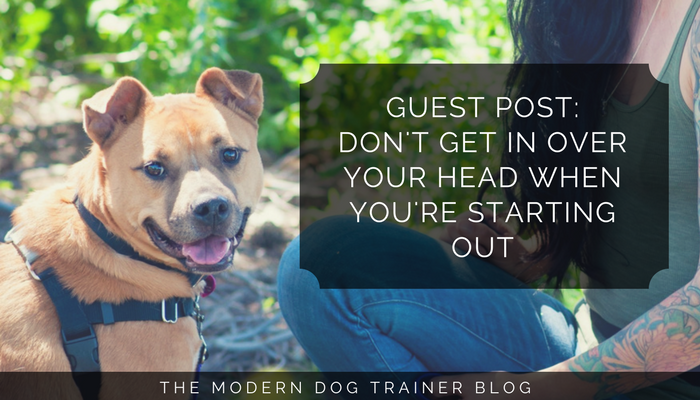
by Ines | Jul 31, 2017 | Business
Today, I’m honored to have a guest post from someone that’s been on the podcast twice (once in 2016 and once in 2017) to talk about a unique challenge that new dog trainers face – taking on clients that you’re not ready for to make ends meet! This scenario has a multitude of implications that I’ll let Rachel explain below.
 Some of the most frustrating situations I’ve encountered in my career as a professional dog trainer is when a positive reinforcement-based trainer takes on cases that they don’t have the skill set for. Don’t get me wrong– these trainers have the best intentions and they genuinely want to help these dogs– but a lot of the time they end up doing more harm than good.
Some of the most frustrating situations I’ve encountered in my career as a professional dog trainer is when a positive reinforcement-based trainer takes on cases that they don’t have the skill set for. Don’t get me wrong– these trainers have the best intentions and they genuinely want to help these dogs– but a lot of the time they end up doing more harm than good.
We are all, for better or worse, in a highly-competitive field with a high overhead and relatively low-income potential. To compete in an oversaturated market, most of us rely on social media in some aspect or another to increase our visibility. However, we must accept and respect when we post on public forums, groups, or even our own Facebook account and get questions or unsolicited criticism about our methods. Without this system of checks and balances, our careers would be even more susceptible to “whisperers,” dominance trainers, and untrained hacks. While I agree that positive reinforcement trainers should be working together for the greater good of the movement, constructive criticism delivered in a non-confrontational manner encourages learning, improvement in training, and continuing progress in the field.
Aside from inter-industry drama, newer trainers might wonder why it’s a big deal if they take on a dog that exhibits problem behavior beyond that trainer’s particular skill set or comfort level. After all, how are we supposed to learn without experience? Isn’t stepping outside our comfort zone how we all continue to grow? My view is that if the desired behavior change isn’t achieved, we’ve taught the pet parent that positive reinforcement doesn’t work. Not only can this harm how the public views positive reinforcement training, a trainer taking on a case above their experience level inherently places the trainer’s learning experience and income potential above the well-being of the dog and expectations of the owners. This is antithetical to our commitment to our craft, our clients, and the animals themselves.
As a thought experiment, imagine a novice dog owner who has a dog displaying “aggressive” behavior, such as snapping at strangers visiting the house. She’s not sure how to address this behavior, and after doing some research she decides to go with a trainer who markets themselves as R+ savvy and force-free. Many, if not most, of these pet parents have at least one acquaintance or a family member who’s told them to use a shock collar or prong collar when the dog aggresses or states something along the lines of, “You just need to be dominant and show that dog who’s boss.” In fact, any day of the week you can turn on the television at a given time and see this advice peddled on TV shows or infomercials. Despite this, the pet parent isn’t comfortable with heavy-handed methods and ends up hiring the R+ trainer. The pet parent works with the trainer for months, sometimes years, but the dog just isn’t making a quantifiable change in the behavior. The pet parent has spent thousands of dollars, but they still don’t feel confident in the dog’s training. The pet parent is now discouraged and believes that R+ doesn’t work for “aggressive dogs.” Out of desperation, the pet parent hires an aversive-based trainer.
This is where good intentions become damaging: that well-meaning trainer was the catalyst that turned this client– a pet owner who wanted to go about training in a non-confrontational way– into a confrontational-based trainer because the R+ trainer didn’t have the correct skill set for that particular client. Had the trainer been honest with themselves and referred the client to a trainer or behavior consultant who specializes in aggressive behavior, the client would have gotten the help they needed using positive reinforcement methods and achieved timely results.
Just as animals need to learn from small approximations and positive experiences to shape behavior, so do we as dog trainers. A trainer with little or no previous experience with aggressive dogs is taking a huge jump in approximation by agreeing to consult on such cases, and the willingness to take such a leap is as much a sign of training naivety as it is a representation of the person’s enthusiasm and excitement to be working in an industry that we all love. Being well-versed in respondent and operant conditioning and canine behavior is the first step, but slow, gradual, and preferably supervised hands-on experience is just as important with cases where the consequences of making mistakes or simple lack of progress is so dire.
I am the first person to admit that there are many situations outside of my experience base. For example, competition and canine sport training is not my forte. Could I train a dog to compete in obedience and agility? Yes. Are there many others who could train that dog more efficiently? Absolutely! And that’s why I refer out those cases to trainers who are better than me in that particular realm without any hesitation.
So please, if you’re a newer trainer who really wants to help pet parents and their dogs succeed with positive reinforcement-based training methods, refer the difficult cases to someone who knows how to handle them and shadow the trainer or behavior consultant that you refer your client to so that you too can learn how to work these kinds of cases. Don’t try to learn by doing and figuring it out as you go; learn by observing a behavior professional through the lens of your understanding the science of behavior.
 About Rachel Golub, CDBC, CPDT-KA
About Rachel Golub, CDBC, CPDT-KA
Rachel started her animal training career at the Escondido Humane Society in 2008. She began as an Adoptions Counselor and was quickly promoted to Assistant Trainer in the Behavior Department. Rachel went on to apprentice under some of the top trainers in Southern California, receiving her certification as a Professional Dog Trainer from the CCPDT in 2010, and in 2016 she received her Certified Dog Behavior Consultant certification through the International Association of Animal Behavior Consultants. In addition to her expertise on dog training, Rachel also has training experience with cats, parrots, exotic animals, and domestic livestock such as horses and pigs.
In 2009, Rachel founded her own company dedicated to rescuing, rehabilitating, and placing dogs with behavior issues. This company evolved into San Diego Animal Training where she continues to consult with rescues, shelters, and private individuals to transform difficult dogs into adoptable, loving companions.
Receive valuable dog training business tips and resources in your inbox.
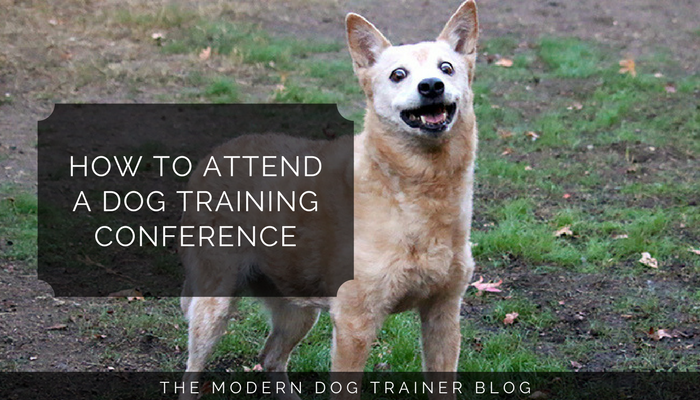
by Kat Camplin | Jul 28, 2017 | Business, Communication, Events
 With the registration date for ClickerExpo coming up, I began to think about what learning goals to concentrate on this year, who I wanted to hear speak, and if there should be a theme or if I should just see whatever sounded interesting. I then began to think about the other part of going to conferences; meeting people and networking. So many times I’ve seen someone I haven’t seen in years passing by in between sessions and had that 7 second drive-by conversation, “Hi! How are you doing! Great to see you! Let’s meet for lunch or something!” The other person responds, “Great!” and then that’s the end of it. This year, I really want to make a plan.
With the registration date for ClickerExpo coming up, I began to think about what learning goals to concentrate on this year, who I wanted to hear speak, and if there should be a theme or if I should just see whatever sounded interesting. I then began to think about the other part of going to conferences; meeting people and networking. So many times I’ve seen someone I haven’t seen in years passing by in between sessions and had that 7 second drive-by conversation, “Hi! How are you doing! Great to see you! Let’s meet for lunch or something!” The other person responds, “Great!” and then that’s the end of it. This year, I really want to make a plan.
1. Put people you want to meet on your schedule.
I always have the best of intentions and every conference I fail. This year I’m putting people on my schedule. Message people and ask them for a time to meet or share a meal or have a drink. Put the appointment on your schedule with a reminder so you don’t become that person that stood someone up at a training conference. You have 3 meals a day, after conference drinks, breaks in between speakers, and skipped session periods you can fill. Fill them. If meals are coordinated and prepaid you might consider skipping one and doing a DIY lunch at least one day to accommodate people who aren’t purchasing meals.
Related: Are drinks after the conference your favorite part of attending conferences? Do you like meeting online friends in-person? Ever wish you had a group of local, friendly dog trainers to chat with to continue the conversation? Check out our latest project: Mastermind Meetups for Modern Dog Trainers
2. You don’t have to fill every session.
I actually learned this when I got violently ill at a conference. Fatigue set in and I needed to prioritize my energy instead of my desire to see everything. There were some session slots where there just wasn’t anything that really perked my interest or I had seen all the presentations already. I skipped that period and took a nap, waking up refreshed for the speakers I really wanted to see. When I skipped and didn’t take a nap, I met a bunch of people that were also skipping! If you’re just trying to fill time by seeing a speaker, meet up with people instead.
3. Introduce yourself to people sitting or eating alone.
If you haven’t filled a meal period with a scheduled meet up then scan the dining area and look for people wearing the conference badge who are sitting alone. Go introduce yourself and ask if they want company. Please don’t push in if the person says they’d rather be alone. Conferences can be overwhelming and some people need quiet time. I’ve had many amazing conversations eating with strangers. Meeting and talking to people way outside your normal circle can be more educational than some presentations. This practice also makes everyone feel welcomed and interesting. Which brings us to number 4.
4. Remember to get cards or contact information for people you meet.
I’m putting this on a post-it note on my forehead this year, “Please give me your business card.” After introducing myself and eating with a stranger and having a lovely conversation, it inevitably happens that the conference bell rings and you’re off and running to the next session. The number of times I’ve grabbed my things and said, “Thank you for the wonderful lunch!” then sprinted away is embarrassing. Take a moment, get a card or have the person put their email address in a note for you. When you get seated at your Must Get To session, make a note of where you met them, what you did together, and the general topic of conversation. Even if you never message them you will have a reminder if you see them at the next conference.
5. Organize meetups with your virtual friends.
We all have them, people we “know” from Twitter, Facebook, certification organizations, clubs, and schools. Schedule a meetup and get a few people you want to meet in one place. On Twitter you can create a hashtag and have people retweet or reply they’d like to join. You can create calendar and Facebook events so other people can invite other people. While it may seem fun to set these up for dinner at a restaurant, some trainers are on a budget. You might consider doing these in hotel common areas instead of restaurants so everyone can bring their own food yet still have dinner together. Remember to send reminders to everyone who was interested when you get to the conference.
Check out our latest project: Mastermind Meetups for Modern Dog Trainers
Did we miss anything? What is your go-to strategy for attending conferences? Tell us in the comments!
Receive valuable dog training business tips and resources in your inbox.
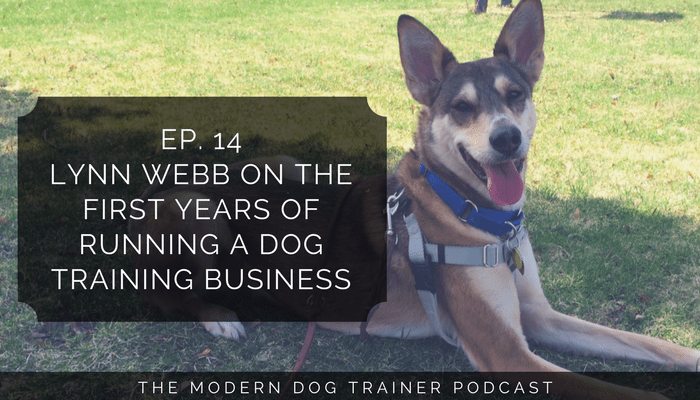
by Ines | Jul 19, 2017 | Business, Podcast
 This episode we had Lynn Webb on the show to discuss what it was like to work through all the unexpected challenges of starting up your own dog training business. Learning how to train dogs is the easy part. Knowing how to run a business with consistent income is the difficult part. Listen as Kat Camplin and Ines McNeil discuss the challenges that come with starting up your own dog training business.
This episode we had Lynn Webb on the show to discuss what it was like to work through all the unexpected challenges of starting up your own dog training business. Learning how to train dogs is the easy part. Knowing how to run a business with consistent income is the difficult part. Listen as Kat Camplin and Ines McNeil discuss the challenges that come with starting up your own dog training business.
Lynn Webb is the owner of The Proficient Pup Dog Training and Massage in North County San Diego. She has over 17 years of experience with animals, much of that time spent with birds, mammals, and reptiles at the San Diego Zoo Safari Park. Working in a zoo gave her the ability to wear many hats, which is also needed when starting and running a dog training business!
 Lynn’s education includes a Master’s Degree, certification in dog training through Karen Pryor Academy, certification in Canine Massage through Rocky Mountain School of Animal Accupressure and Massage, and certification in Pet First Aid and CPR through PetTech. Her passions include dogs, learning, and teaching.
Lynn’s education includes a Master’s Degree, certification in dog training through Karen Pryor Academy, certification in Canine Massage through Rocky Mountain School of Animal Accupressure and Massage, and certification in Pet First Aid and CPR through PetTech. Her passions include dogs, learning, and teaching.
Subscribe to The Modern Dog Trainer Podcast on SoundCloud or iTunes. Follow The Modern Dog Trainer Blog on Twitter at @ModernTrainer, on Facebook at The Modern Dog Trainer Blog Page, and on Instagram at @TheModernDogTrainerBlog. Don’t forget to join our FREE Facebook Group, “Startup Tips for Modern Dog Trainers.” We love hearing from our listeners!
Please leave us a review on iTunes to help support our podcast!
Show Notes
You can find Lynn here:
Receive valuable dog training business tips and resources in your inbox.
![Questions People Asked Before Signing Up for the “How to Start a Successful Dog Training Business” Course]()
by Ines | Feb 16, 2017 | Business
 If you haven’t heard yet, I’ve created a course to help new dog trainers start up their businesses correctly and with ease. When you’re first starting out, I understand all the questions that are running through your head at any given moment.
If you haven’t heard yet, I’ve created a course to help new dog trainers start up their businesses correctly and with ease. When you’re first starting out, I understand all the questions that are running through your head at any given moment.
When I was starting my own dog training business I spent dozens of hours researching business terms and requirements and asked my mentor what seemed like a million questions. I was lucky to have a mentor, but I know that there are a lot of trainers out there on their own either with no one else around to mentor them, surrounded by other dog trainers that are too competitive to share their knowledge, or are even getting misleading or incorrect information and recommendations from their mentor. (Scary!)
About this Dog Training Business Course
Late last year, I created the course “How to Start a Successful Dog Training Business” which is a 12-week, step-by-step course to launching your dog training business. It includes three months of lessons and actionable instructions on the business, marketing, and client management aspects of starting a dog training business.
On top of lifetime access to a Facebook group and your own set of the popular dog training business template bundle, each week you get a new lesson to teach you about the ins and outs of a dog training business and handouts to help you prioritize and execute your tasks as a new business owner.
My goal is to help dog trainers all over the globe that value
- having a business that’s set up quickly, but also correctly and legally
- protecting themselves and their families from the liabilities of being a dog trainer
- building a business that is sustainable for years to come
- taking their dog training hobby and want to make a real career out of it
With the help of this course, my goal for you is to:
- get your business established and running within 12 weeks (including getting your LLC, insurance, taxes, client policies, website, social media, and services in order)
- save you dozens of hours of research and give you the confidence to set up your business correctly and legally
- use smart digital marketing techniques to drive traffic to your website and calls to your phone within one week of completing the course
- start accepting new clients by the end of the course knowing you’re a true professional
- have a business that supports you emotionally and financially for years to come so you can do what you love!
Join my Facebook Group “Startup Tips for Modern Dog Trainers” for a 30% discount!
Join the Facebook Group
Questions I’ve Gotten From Dog Trainers About This Course
“Is this course too good to be true?”
I literally had someone open up to me and ask me this! I was pleasantly surprised to hear this question because it means that I was really hitting on some key aspects of starting up a dog training business that aren’t already being addressed by anyone else.
The answer is simple – no, it’s not too good to be true, but it is that good! It might seem like it since I address and help you over come a lot of challenges that new dog trainers face – things that people don’t want to admit or things that others don’t like to talk about (hello liabilities!). I know what it’s like to be just starting out so I know what questions are going through your mind right now. Additionally, when you’re getting started, you don’t know what you don’t know (just like when you first started training dogs) so I’m here to bring awareness of some critical parts of your business’s success.
“Will all my questions be answered?”
While the course is written to be as thorough as possible, it’s impossible to consider every minute situation or question you might come across. That’s why it includes a lifetime membership to the course’s Facebook group. This group is meant for participants to support each other and I spend some time each week answering questions or providing feedback on things like your website, insurance needs, policies to consider for clients, and more.
“Is it worth it? It’s a lot of money and I just want to be sure before I invest such a large sum.”
With all the online products at are available these days, I understand your concern. I would be asking the exact same question! Fortunately, you can rest assured that this is an authentic, handwritten course by someone that’s been in your shoes and understands what you’re up against. I know that starting your own business is scary. With all the business terminology and tasks to get done, it’s easy to overlook some important steps to setting up your business correctly which is why I’ve taken the time and energy to write this course.
It took me many, many, many hours of research and a lot of trial and error to iron things out for my business and I don’t wish all that time wasted and those sleepless nights on anyone. Start your business off on the right step and get clients in the door safely and quickly with the help of this course.
There is a lot that goes into starting up a business. I walk you through all the most important steps so you can be confident you’re addressing everything that needs addressing such as:
- the correct business structure
- taxes
- insurance
- policies for clients
- services
- marketing tactics that will actually work
Check out what one of my course participants had to say about her investment into this course:

“Is this a specific 12-week program, or can we sign up at any time?”
It is open enrollment so you can join anytime! I know everyone it at a different stage in their business so I wanted to make it available whenever you’re ready to get serious about starting your business.
This is a 12-week course delivered to your email once a week. The benefit of receiving it in your email is that you will always have access to it. It’s not like a membership website where you have to keep paying monthly for access to the material. With this approach, you’ll have the content for as long as you have it in your inbox or you can even download it to your computer.
If 12 weeks is too fast, you can take the course at your own pace by bookmarking the emails as they come and opening them up only when you’re ready to take action. Simple!
If you’re interested in learning more, you can join the Facebook group. You’ll see a pinned post with the link and you can join in the discussion in general!
Free eBook: 10 Common Mistakes New Dog Trainers Make With Their Businesses
 Are you making the same mistakes I made when I was first starting out?
Are you making the same mistakes I made when I was first starting out?
If you want to be able to make a living by doing something you love, you have to make the right decisions along the way that will sustain and support your passion. In this eBook, I’ll warn you of potential mistakes you might be on the verge of making or already are making so that you can course-correct and make improvements that will positively affect your business.
Are the decisions you’re making around business, marketing, services, and client management the right ones? Find out in this eBook!
View the eBook

by Ines | Feb 8, 2017 | Business
If you’re starting out on your own as a professional dog trainer with your very own business, you might have a lot of unanswered questions. In this post I’ll address some of the common concerns new dog trainers have about start out on their own. (To join in the discussion – join my free Facebook Group!)
Not Knowing If You’re Qualified Enough to Be a Pro
 This subject will always be up for debate – at least until this industry becomes more regulated. It is extremely rare to find a dog trainer that could be considered 100% “qualified” to take on any case that comes her or his way. It is much more important to understand your preferences and limitations so that you can filter out cases that could be too much for you to handle.
This subject will always be up for debate – at least until this industry becomes more regulated. It is extremely rare to find a dog trainer that could be considered 100% “qualified” to take on any case that comes her or his way. It is much more important to understand your preferences and limitations so that you can filter out cases that could be too much for you to handle.
Don’t beat yourself up because you think you don’t have exactly the right education or experience to even begin. (I know as dog trainers we can be overly critical of our skills… ) Only those who get started will ever have the ‘right” experience. You have to get started now to become great someday! At the very least, you can get started with clients that are struggling with some of the issues you first faced when you were introduced to dog training. If you’ve taken some dog training classes, read several dog training books or watched several dog training DVDs, or even taken a structured program such as KPA, you’ve got more knowledge and skills than the average dog owner out there and they sure could benefit your help!
If you’ve taken some dog training classes, read several dog training books or watched several dog training DVDs, or even taken a structured program such as KPA, you’ve got more knowledge and skills than the average dog owner out there and they sure could benefit your help!
The important part is making sure you’re not going to cause more harm than good when you take on a case. Asking the right questions before accepting a new client can help you stay in your comfort level and avoid scary situations. Find someone you’re comfortable referring out cases you don’t feel confident taking.
Not Knowing If Your Community Can Support Your Dog Training Business
Some trainers might be wondering if their local community is even big enough or wealthy enough to support their dog training business. That’s why I created a 5-day mini-course to walk you through some basic market research. The fact is that if you focus on a certain kind of person with a certain kind of problem (otherwise known as a “niche”) you can become the go-to person in your community for that specific situation.
Specializing will set you apart from any competition. No matter the size of your community, find a way to solve a specific need with your services at the right price point and you can have a successful business!
Not Knowing When to Go Fulltime
There isn’t a simple answer to this. Only you will know when it is time to take your business full-time. For new dog trainers, I recommend that you get your business set up and running for a few months before this even becomes an option. There is no need to rush into it and stress yourself out trying to make ends meet.
Once dog training becomes your profession instead of your hobby, there are the added pressures of needing to pay the bills. This can lead to taking on cases you’re not really ready for in order to pay the bills. This isn’t good for the client, the dog, or your mental health.
Establish a good client base and find some ways to generate repeat business before you go full time. Also, learn how to turn existing customers into repeat business. This is key to having a sustainable dog training business! Always needing to find and acquire new clients to fill your schedule is the hardest route to take so make sure you have services and offerings that encourage repeat business.
Once you have a more consistent month-to-month schedule, consider what expenses you can reduce so that you don’t have to make quite as much once you’re full time to make ends meet. You can also consider asking your current employer to go from full time to part time to help supplement your new full-time business. You might be surprised to find support from them. It doesn’t have to be a “cold turkey” switch to dog training full-time. Weigh all your options and set yourself up for success with small steps to reach your goals.

Not Having the Right Level of Protection From Liabilities
This isn’t a direct obstacle, but it could affect your long-term success as a dog trainer. Failing to have the right processes in place could be detrimental to you and your family financially. Don’t be ignorant to the liabilities you’re taking on as a dog trainer.
- Business Structure – Understanding the liabilities you’re taking on will help you decide which type of business structure you should choose. Being naive of the situations you could be held liable for could leave you, your family, and your personal finances vulnerable. Having the right business structure is incredibly important to having a successful business.
- Insurance – Having the right insurance is a part of being a professional in any industry, but dog trainers, especially, require some unique insurance policies. When you’re working with live animals, children, and people, mistakes are bound to happen.
- Have the Proper Policies in Place to Protect Yourself – As a service-based business, you’ll be working with people and their dogs day in and day out. You need to establish good policies before you need them or it could lead to bad reviews, burnout, or even lawsuits.
In my course, How to Start and Run a Successful Dog Training Business, I walk you through the steps to setting up your own LLC and show you exactly what you need coverage for with your insurance. If you work with dogs, you *have* to carry insurance. It’s a non-negotiable in my book.
Not Knowing The Taxes You’ll Be Newly Responsible For
Failing to file the right taxes at the right time or not charging sales tax when you should be could lead to some costly consequences and be detrimental to the success of your business.
In my course, I cover the taxes you may be held responsible for. I also provide you a checklist of questions to ask a potential CPA before you hire them.
If you’re considering becoming a professional dog trainer, check out what this course has to offer. Facebook Group members and people who have read the eBook or taken the 5-Day Mini-course get 25% off!
Finding The Right (Affordable) Software To Manage Clients
As you start to acquire customers, you’ll have an ever-increasing number of people to stay in touch with. Furthermore, you’ll need to segment your customers and potential customers so that you can provide them information that is relevant to them. A customer that is actively taking lessons with you should not receive the same messaging as someone who has just discovered your business.
In my course, I analyze some software options that are available that best-fit dog trainers’ unique needs.
Not Offering the Right Services at the Right Prices
The better you understand your customers and potential customers, the better you can serve them with solutions to their challenges at the right price point. You don’t have to offer the same basic services that everyone else offers. Get creative and find ways you can better serve your clients. Additionally, like I already mentioned above, finding services to offer that generate repeat business is critical to long-term sustainable success.
Wasting Money On Ineffective Marketing
You can live in a great community, but if you can’t reach your ideal customers with the right marketing message at the right time and place, your business will struggle. Half-hearted attempts at Facebook Ads or throwing money at Yelp will not typically result in new clients and when you’re first starting up, every dime you spend on ineffective marketing is painful.
Additionally, not implementing some marketing strategies, like email marketing, can leave you empty handed even if you’re able to generate traffic to your website. If someone isn’t quite ready to call you for help, but are still interested in hearing more from you, setting up an email marketing list is key!
In my course, I include a few modules that walk you through setting up a website, setting up your social media profiles, and how to get started with Google AdWords and Facebook Ads to generate new client inquiries quickly and affordably. (Again, join my Facebook group for a 25% discount!)
In my Facebook group, I’m working on building a community of like-minded modern dog trainers and am teaching them the ropes of starting up a successful dog training business. If this year is the year you’re committing to starting out on your own, this group will offer you priceless advice and tips for getting started.
Don’t let these obstacles stop you from having the career of your dreams! In the end, it is so worth it to be able to help dogs and their people every day. You can be your own boss and work your own hours while being a valuable part of your community. These obstacles can be easily overcome with the right resources.
If you’re serious about becoming a professional dog trainer with your own business, join this group to get detailed tips to starting up a successful dog training business of your own. Share your stories and challenges, and learn from other’s experiences.
I host the occasional Facebook Live events to walk you through some of the toughest parts about getting started!
![Questions People Asked Before Signing Up for the “How to Start a Successful Dog Training Business” Course]()
by Ines | Jan 30, 2017 | Business
“Why don’t my clients follow my instructions? The training would go so much more smoothly and progress much more quickly!”
“I wish my clients wouldn’t text me 1 hour before our lessons and cancel!”
“How do I get my clients to stop calling and texting me outside of my business hours? I’m never off the clock and it’s exhausting!”
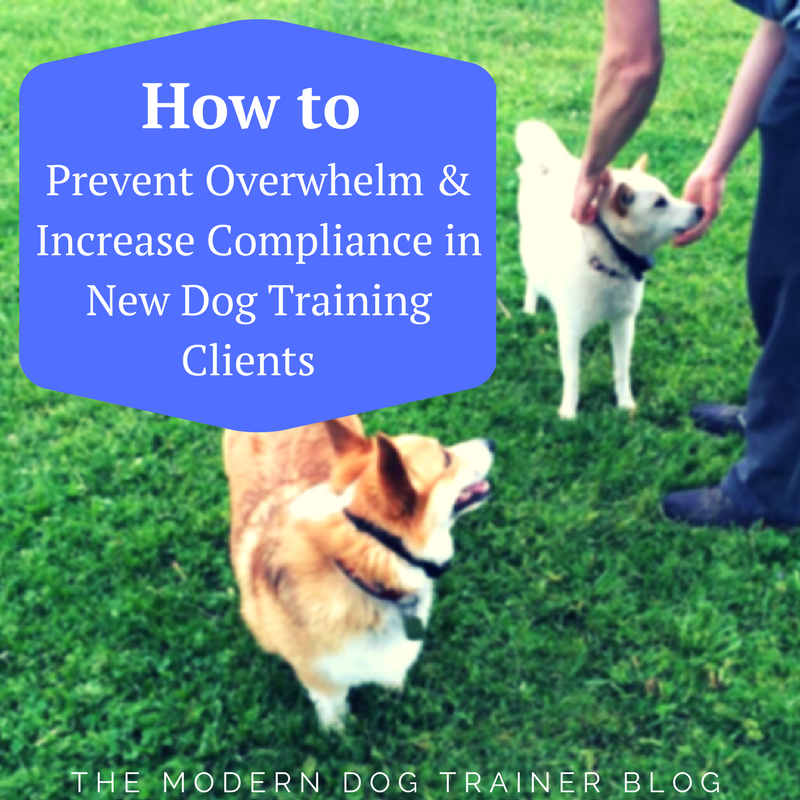 What if there was a way to help your clients behave in the way you want them to? To eliminate their confusion and improve their compliance with your training program?
What if there was a way to help your clients behave in the way you want them to? To eliminate their confusion and improve their compliance with your training program?
Fortunately, there is. Client’s behavior is actually remarkably similar to dog’s behavior. They behave in the only way they know how – until they’ve been taught differently.
You can put some processes in place to protect your schedule, income, and “time off the clock.” Just like when you set up the environment for a dog to choose the right behavior – you can have the same approach when working with your (human) clients.
Understand Your Client’s Whole Situation
A dog’s behavior is always impacted by its environment. The people, home, community, and so many more variables affect how you will approach their training goals. Ensuring that you gather all the right information up front in a dog training client-intake form or in-person evaluation is critical to crafting a dog training plan. (That’s one reason I created these templates for my readers.)
Family & Compliance
To get even deeper than what’s on paper, you’ll want to dig into the reasons why the family is interested in training. Often, a spouse or family member is unhappy with the current living situation with the dog. Address their concerns, understanding where they’re coming from, and showing how the training plan will address their challenges will improve compliance greatly.
It’s not enough to say, “Ok, you need to teach the dog how to sit, stay, and walk nicely on a leash.” You’ll need to explain why and how the training program will help them reach their goals. This small extra step will help get the entire family on board for training and motivate them to stick through it. Showing them why their homework is important can help reduce the feeling of overwhelm.
Lifestyle
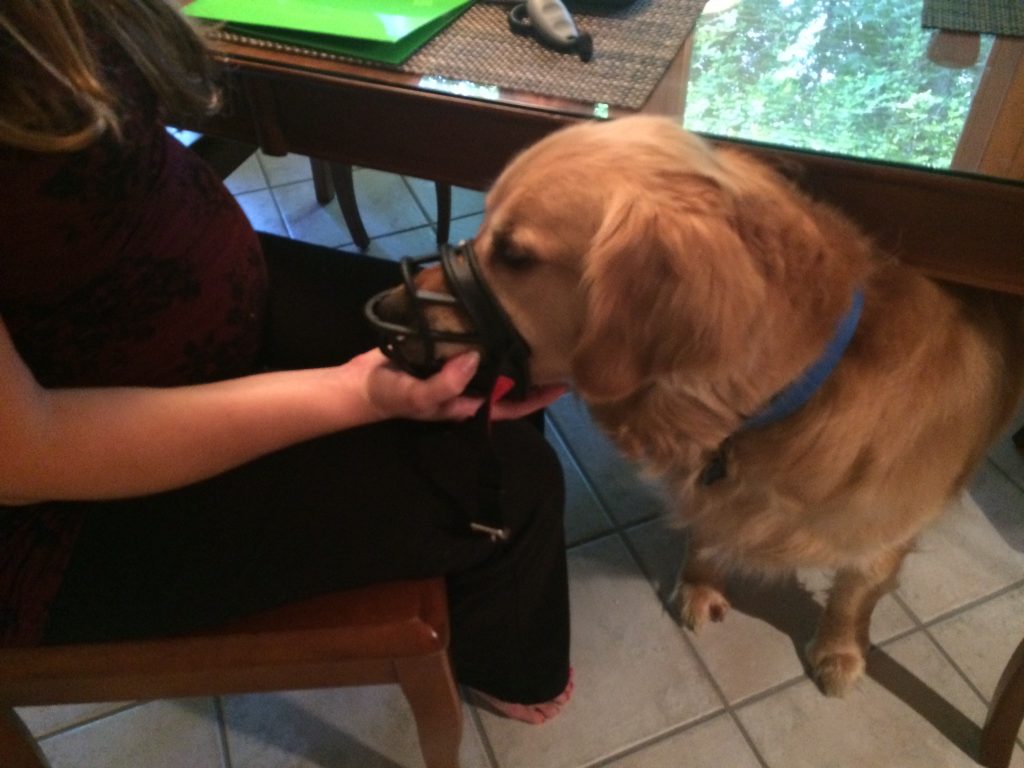 Thorough questions when you first begin working with a client will help you understand their situation and lifestyle. Whether they are a busy family of 5 always running left and right to sports practice or a busy professional that travels 3 weeks out of each month, these details on their lifestyle will help you understand their capabilities and design a training program that will best suit their needs. By truly understanding your client and being flexible, you can provide the right services to help them reach their dog training goals more quickly and effectively.
Thorough questions when you first begin working with a client will help you understand their situation and lifestyle. Whether they are a busy family of 5 always running left and right to sports practice or a busy professional that travels 3 weeks out of each month, these details on their lifestyle will help you understand their capabilities and design a training program that will best suit their needs. By truly understanding your client and being flexible, you can provide the right services to help them reach their dog training goals more quickly and effectively.
While there are compromises and improvements that can often be made, it’s not your responsibility to change someone’s lifestyle to match their dog. As a dog trainer, you have to help the dog adapt to the client’s lifestyle and goals as much as possible. (Unfortunately, when this isn’t possible, rehoming a dog might be the best solution for everyone’s mental health.)
Failing to fit their training program inside their current lifestyle could be asking your client to change too many things about themselves to have good compliance and a successful training program. Don’t try to put a square peg in a round hole. A client that is extremely overwhelmed could lead them to believe you’re not the right fit for their needs and could even result in a bad review online. Great dog trainers understand their client’s limitations and provide a plan that adds responsibilities and changes incrementally instead of all at once.
Understanding Their Priorities
Similar to understanding a client’s lifestyle, knowing what your client’s priorities are is critical to motivating them. However, understanding their priorities isn’t quite as simple as it might seem. If a client says they want to teach their dog to “sit,” you have to dig deeper into their motivation for wanting this behavior. Is their priority to have a dog that behaves around visitors? Do they want their dog to listen to them around their children? Do they want their dog to become a therapy dog eventually?
Don’t take client’s requests at face value. Ask why (a few times) and see what your client truly wants from their dog. When you understand your client’s priorities, you can create a plan that satisfies their needs and increase their compliance. Don’t just go by what you think should be the priority for their situation. They have to be on board, too.
Establish Policies to Protect Your Sanity
One of the best ways to prevent overwhelm and get better compliance with new clients is to make sure they know the “rules and expectations” before they even begin working with you. In the template bundle, I provide a welcome packet that you can use to list out your expectations around communication, office hours, how lessons or classes work, and other processes that will help your clients understand how to work with you.
Being clear, concise, and consistent with clients will help them be successful (just like dog training, right?) A welcome packet answers those FAQs and gives you a foundation in case you need to enforce one of your policies.
 Decrease Overwhelm & Increase Client Compliance with the Right Forms
Decrease Overwhelm & Increase Client Compliance with the Right Forms
As dog trainers, we know that prevention is always the best policy and preparation is the best form of prevention. I want you to feel confident and professional in your business which is why I created the New Dog Training Business Template Bundle. This bundle includes an in-depth new client intake form, in addition to 9 other templates, that you can start using today.
View the New Dog Training Business Template Bundle here.
![Questions People Asked Before Signing Up for the “How to Start a Successful Dog Training Business” Course]()
by Ines | Jan 24, 2017 | Business
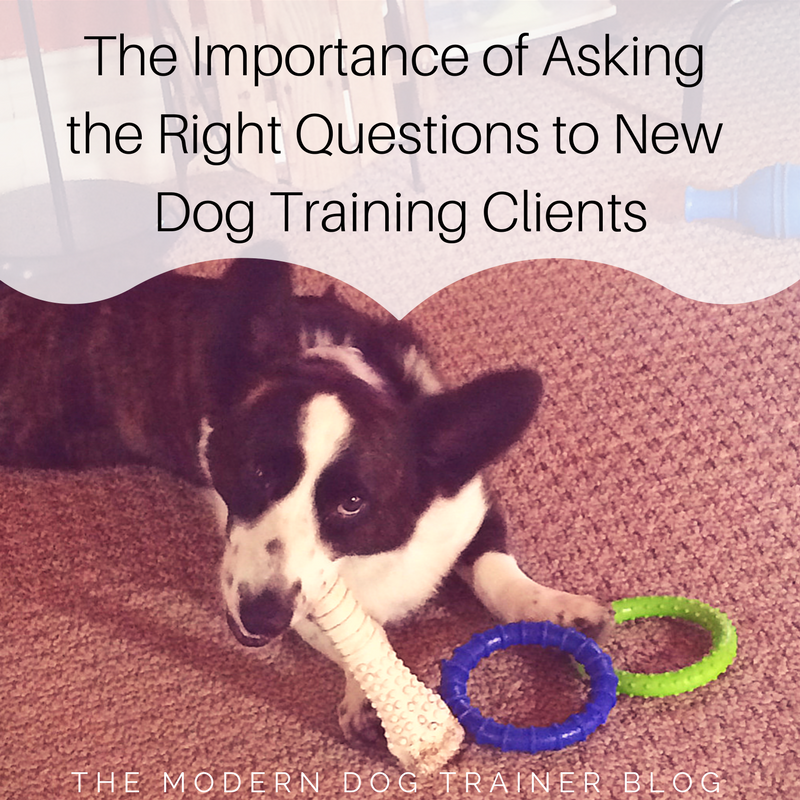 Mentors Prevent Mishaps
Mentors Prevent Mishaps
Knowing the right questions to ask new clients often comes after many years of experience for many professional dog trainers. There are many situations that a new dog trainer may not be aware of or familiar with because they haven’t come across them yet. Ultimately, you don’t know what you don’t know and this can put you in an uncomfortable position if you’re not careful when taking on new clients.
This is often where working with a mentor can be priceless. Mentors can teach you how to onboard new clients, manage clients, and manage other aspects of running a small business – let alone a dog training business. A mentor can teach you what you should look out for and what questions to ask new clients before taking them on so that you can provide them with the best training program possible to get results. Their stories can give you insights into what to lookout for with your own clients so you can set yourself up for success. However, not everyone has access to a mentor which is we try to fill in the gaps with this website, podcast, and Facebook groups.
If you don’t have a mentor to teach you the ropes or what red flags to look for, the second best option is to make sure you’re asking the right questions to new dog training clients so that you’re fully aware of what you’re taking on before you commit to training their dog.
What Could Happen If You Don’t Ask New Clients The Right Questions?
Because dog training is completely unregulated, many dog trainers start out without much formal training at all – especially when it comes to business or client management. This results in well-meaning, but uninformed dog trainers taking on clients they aren’t necessarily ready for. They may not be aware of the risks or unfortunate scenarios that could result from taking on certain clients.
Fortunately, there is a way to avoid complicated or risky situations – asking the right questions before taking on a new client.
Speaking from experience, I’m quite certain that there are many new dog trainers out there that are taking on cases with a bite history too prematurely simply because they didn’t ask the right questions before working with a client. Many dog training clients leave out important details from intake forms or conversations because they assume those details irrelevant to their training goals.
For example, a client could inquire about basic obedience and manners with their dog, Fido. Fido has a long history of resource guarding his food and toys from people and other dogs. Their assumption is that Fido’s resource guarding behavior with a small bite history is irrelevant to their basic obedience goals and they choose leave out those details. A new dog trainer may not assume an inquiry about obedience requires an in-depth intake form or questionnaire and so they leave out important questions that could have uncovered these details. This kind of scenario happens all too often and leaves the dog trainer in an unsafe situation with the potential for a lawsuit if something goes wrong a group class with other students.
This is just once scenario in which asking detailed, seemingly irrelevant questions before taking on a new client can help prevent unexpected, dangerous accidents. Without a mentor to teach them otherwise, a new dog trainer may not be aware of the risks they’re unknowingly taking on.
 What To Do If You Don’t Have a Mentor
What To Do If You Don’t Have a Mentor
Through this blog, podcast, and courses, I hope to educate those that are just starting out so that they don’t find themselves in scary situations. As dog trainers, we know that prevention is always the best policy and preparation is the best form of prevention. We work with animals and people which can lead to unpredictable situations. I want you to feel confident and professional in your business which is why I created the New Dog Training Business Template Bundle which includes an in-depth new client intake form, in addition to 9 other templates, that you can start using today.
Additionally, I’ve got some exciting events coming up for new dog trainers starting up their own business!
Join Me for Facebook Live February!
In the month of February, I’ll be doing Facebook live videos every week in our Facebook group, “Startup Tips for Modern Dog Trainers.“ Be sure to join the group so you can also benefit from all the free tips around starting up a dog training business I’ll be sharing. At the end of the month, I’ll be hosting a workshop for new dog trainers looking to start their own businesses so stay tuned!
Join the Facebook Group

by Ines | Jan 17, 2017 | Business
 Ever wonder if your city is big enough for you to start your own dog training business? What about if people in your community make enough to pay for a professional dog trainer? Questions like these and others can be answered with smart market research.
Ever wonder if your city is big enough for you to start your own dog training business? What about if people in your community make enough to pay for a professional dog trainer? Questions like these and others can be answered with smart market research.
If you’re wondering whether you should try to “make the leap” as a professional dog trainer with your own business or not, market research can help you confirm or refute your assumptions.
The Purpose of Market Research
Market research done right will help you understand the kind of people you want to serve and will provide answers to questions like:
- Who should I serve in my community?
- What services should I offer?
- What are people in my area willing to pay for?
- Should I specialize? If so, what specialty should I focus on for my location?
- Will I have enough customers to support my business?
- What should I charge for my services?
- How can I differentiate myself from my competitors?
- How can I serve my customers better than my competitors could?
I see a lot of these questions being asked in Facebook groups by new dog trainers, but the answers you might get on Facebook could be irrelevant or mislead you because they don’t consider your geographic area and the demographics that are represented.
Gather General Population Statistics
Some specific statistics you should pay attention to as a dog trainer and make a note of include:
- Population within your service area
- Personal income per capita – This is considered the average income earned per person in a given area in a specified year. It is calculated by dividing the area’s total income by its total population.
- Growth or decline in either population or personal income over the last 10 years.
- Percent of the population that own dogs
- General demographics of the population – Is the general population mostly families with small children or are they an aging community with lots of retirement centers?
Market Research is About More Than Statistics
The best market research involves getting out there in your community and asking real people about their lives and their struggles. Statistics are known as secondary information. Primary information is the information you gather directly from the source – your future customers!
In an effort to help my readers and new dog trainers out there, I’ve created a FREE 5-day email course to walk you through the steps of market research. I’m really excited about this course because I see so many newcomers ask if their current city can support a new dog training business if they start one. This course will make it easy to answer that question and so many more that people typically have when they’re starting out.
Learn more about the course and sign up for FREE below!
 Free Market Research Mini-Course for Dog Trainers
Free Market Research Mini-Course for Dog Trainers
Sign up for my 5-day course, “Market Research Course for The Modern Dog Trainer.” In this course, I’ll send you five modules (one each day) that should take you no more than 15-30 minutes to complete.
The five modules include:
- Module 1: Ask the Right Questions to Find the Right Answers
- Module 2: Gather Important & Relevant Stats on Your City’s Population
- Module 3: Learn About The Dog Owners in Your Community
- Module 4: Research Your Competitors & Find Differentiators
- Module 5: Learn About the Factors that Contribute to Sustainability & Success as a Dog Trainer
With the help of this course, you’ll:
- Learn what questions you should ask and research before getting started.
- Find out if your city is populated and economically strong enough to support your dog training business.
- Learn about the specific challenges that dog owners in your community are struggling with.
- Understand what your community needs from your dog training business.
- Feel confident knowing that you’ll be investing time and money into a business that actually has a chance at being successful.
- Have fewer fears about starting up your own dog training business.

Fill out the form below to join the course for FREE!
Sign up for my 5-day course, “Market Research Course for The Modern Dog Trainer.” Receive five modules (one each day) that should take you no more than 15-30 minutes to complete.
Feel confident knowing that you’ll be investing time and money into a business that actually has a chance at being successful.
![Questions People Asked Before Signing Up for the “How to Start a Successful Dog Training Business” Course]()
by Ines | Jan 10, 2017 | Business
This is a guest post by an up and coming positive gun dog trainer in California. In this post, he talks about what it’s like to start up a dog training business from the ground up. Learn about how he got started and the opportunities he pursued to help the transition.
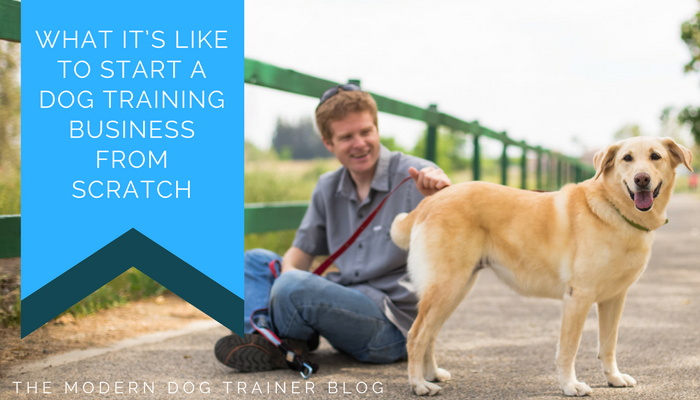 Hello! My name is Zane Brown and I own and run Reliable Retrievers LLC in Fresno, California. I opened my dog training business in late 2016. I’m here to share my story of what lead me to open my own dog training business and what it was like along the way.
Hello! My name is Zane Brown and I own and run Reliable Retrievers LLC in Fresno, California. I opened my dog training business in late 2016. I’m here to share my story of what lead me to open my own dog training business and what it was like along the way.
The start of my journey to become a dog trainer happened at a time when I really didn’t realize how my life’s direction would change, or even what the significance was at the time. In 2014, a Labrador puppy came into my life that would change it all for me. This young pup and I had such a unique bond. He inspired me to take a positive reinforcement obedience class, and before I knew it, I was hooked. I was fascinated with what you could achieve with this revolutionary new method.
 Now, on to the events that helped me to realize my dream and take the first step. It all started in early 2016 when I got an email from Thomas Aaron of Fetchmasters LLC in Denver, Colorado. I had been emailing back and forth with Tom for several months about positive gun dog training. One of the first things that we had talked about was that he held workshops every year but he wasn’t sure when the next one would be. I kept eagerly checking his website every few weeks, but never noticed any update. Then, one day, Tom emails me and tells me that the workshop is on for this coming May, and that there might even be a scholarship available, if I acted now. I quickly emailed Tom back and said I was interested in attending!
Now, on to the events that helped me to realize my dream and take the first step. It all started in early 2016 when I got an email from Thomas Aaron of Fetchmasters LLC in Denver, Colorado. I had been emailing back and forth with Tom for several months about positive gun dog training. One of the first things that we had talked about was that he held workshops every year but he wasn’t sure when the next one would be. I kept eagerly checking his website every few weeks, but never noticed any update. Then, one day, Tom emails me and tells me that the workshop is on for this coming May, and that there might even be a scholarship available, if I acted now. I quickly emailed Tom back and said I was interested in attending!
This was what I had been waiting and hoping for, I couldn’t let this opportunity slip away. As excited as I was, I was also a little nervous because of the monetary commitment: there was the hotel (with a dog no less!), 3 meals a day, half day boarding for my dog (while we attended the lecture part) and finally the gas I would have to spend for the 9 days. However, this is what I wanted to do and positive training was my passion, so I took the leap of faith, and I haven’t looked back since. I decided that the pros would vastly outweigh the cons in taking this chance because I would get to learn a friendlier way to train gun dogs, something that was of a very personal significance to me. I grew up around the traditional way of training gun dogs, yet I had always wanted to find a friendlier, more positive way to train them. Something about the nature of positive reinforcement techniques just resonates with who I am as a person.
The 9 days were incredible. We learned so much about the fundamentals of dog training, had some fun times working in the field, and made some lasting friendships along the way.

Starting Up My Dog Training Business
When I returned home, I wasn’t really sure where to start, but I knew I wanted to get the ball rolling and start working with dogs. It was a little nerve-wracking, but I decided I wouldn’t that let stop me. To be honest, I wasn’t sure when my next day paycheck would come in, and that really terrified me because I had always been rather conservative with money.
Well, the ball took a while to “get rolling.” For my specific venue of dog training, there were certain things I would need; the main one being a safe and legal location to discharge firearms. One of the biggest challenges has been looking for land to lease that would accommodate these needs. Another major challenge has been self-confidence, which I believe goes hand in hand with the fear and uncertainty of whether or not your business is going to thrive and succeed. For a while there, I was unsure of my abilities to train dogs, despite all I had learned.
One of the things that I discovered in starting my own business is that there is a factor of uncertainty to this whole process. This is not meant to scare anyone reading this. It’s just a reality that I want to share so that you understand. You can’t let the uncertainty stop you if you want to work for yourself. With that said, I think that it is important to realize that you can ask for help, and that there is nothing wrong with that. In starting your own business, it is definitely a bonus to have support and someone who has been through the process and can guide you. If you’re starting your own business and you’re stuck, there is help and support out there. Please feel free to reach out to me.
Recommended Reading: Why You Should Do Some Market Research Before Starting Your Dog Training Business
Business Tips for Dog Trainers
Perhaps one of the most significant events in my journey so far was when I found The Modern Dog Trainer and Ines McNeil. A friend of mine invited me to join a Facebook group all about startup tips for dog trainers. Up until this point, I lacked a little bit of focus on getting things started, but with the tips from Ines, that cleared up quickly. I think the major factor that helped clarify the process and gain a good sense of direction was The Modern Dog Trainer business course. One of the main ways that it helped me was to know how to appropriately protect myself legally. It’s a topic that no one wants to talk about, but it’s a necessity if you’re going to be a dog trainer. Another way is it helped me with knowing how to build my website and how to market myself. These things are essential in today’s world. You have to have an online presence and you have to get your name out there.
Getting My First Client
 I will just share one last quick story. I was really nervous about who my first client was going to be. However, one day, a few days ago in fact, I decided to grab the bull by the horns and just go for it. A prospective client emailed me about my services and after talking with a trainer friend of mine I felt a surge of confidence and responded to the client. During this conversation, I realized that I had an idea about where exactly I wanted to start with this client in the training process. It was also the fact that he came to me not just for dog training, but also for advice on hunting itself. It hit me that I had been hunting since I was about fifteen and I knew a lot about it. I have a lot of hunting experience, and done different types of hunting (upland, waterfowl). These are the things that gave me this boost in confidence.
I will just share one last quick story. I was really nervous about who my first client was going to be. However, one day, a few days ago in fact, I decided to grab the bull by the horns and just go for it. A prospective client emailed me about my services and after talking with a trainer friend of mine I felt a surge of confidence and responded to the client. During this conversation, I realized that I had an idea about where exactly I wanted to start with this client in the training process. It was also the fact that he came to me not just for dog training, but also for advice on hunting itself. It hit me that I had been hunting since I was about fifteen and I knew a lot about it. I have a lot of hunting experience, and done different types of hunting (upland, waterfowl). These are the things that gave me this boost in confidence.
I also remembered words from another trainer-friend of mine, “You have to start somewhere.” So, that is my story, or at least the beginning of it. It began with the unique connection between a dog and his human, and it has grown into so much more that. However, I believe it’s important to remember where it all started, whom it started with, and remember the humble beginnings.
My Future Goals
One of my biggest goals is to spread awareness of positive reinforcement gun dog training in California. In addition to offering training services, I want to start an educational division of my business where I offer workshops and seminars to demonstrate the power of positive methods on dogs.
I also want to affect change on a national level, starting with the Boy Scouts of America organization. As an Eagle Scout, I know firsthand just how important this organization is in the lives of young people. There are a lot of critical skills that this organization teaches. I wish to aid in that effort by discussing with them and presenting them with a science-based, proven, positive reinforcement methods for their Dog Care merit badge requirements. It is my hope that positive reinforcement training continues to gain traction and a foothold in the world of hunting dogs.
 Looking into starting your own dog training business? Grab our free eBook, “10 Common Mistakes New Dog Trainers Make With Their Businesses.”
Looking into starting your own dog training business? Grab our free eBook, “10 Common Mistakes New Dog Trainers Make With Their Businesses.”
If you’re thinking about starting your own dog training business, take advantage of this free eBook to avoid some detrimental mistakes that many dog trainers make.
Are you spending your time on the right tasks to grow your business? Are you worried about making continuous income throughout the year? Will your business be sustainable for years to come? Prepare yourself with the help of this eBook!
Get the eBook

 A mastermind meetup is a group of like-minded individuals that get together from time to time to share their goals, obstacles, experiences, and insights to benefit the group as a whole. You learn from each other, you keep each other accountable, and
A mastermind meetup is a group of like-minded individuals that get together from time to time to share their goals, obstacles, experiences, and insights to benefit the group as a whole. You learn from each other, you keep each other accountable, and  4. You’ll Gain Industry Insights Found Nowhere Else
4. You’ll Gain Industry Insights Found Nowhere Else

 About Rachel Golub, CDBC, CPDT-KA
About Rachel Golub, CDBC, CPDT-KA

 Lynn’s education includes a Master’s Degree, certification in dog training through Karen Pryor Academy, certification in Canine Massage through Rocky Mountain School of Animal
Lynn’s education includes a Master’s Degree, certification in dog training through Karen Pryor Academy, certification in Canine Massage through Rocky Mountain School of Animal  If you haven’t heard yet, I’ve created a course to help new dog trainers start up their businesses correctly and with ease. When you’re first starting out, I understand all the questions that are running through your head at any given moment.
If you haven’t heard yet, I’ve created a course to help new dog trainers start up their businesses correctly and with ease. When you’re first starting out, I understand all the questions that are running through your head at any given moment.


 This subject will always be up for debate – at least until this industry becomes more regulated. It is extremely rare to find a dog trainer that could be considered 100% “qualified” to take on any case that comes her or his way. It is much more important to understand your preferences and limitations so that you can filter out cases that could be too much for you to handle.
This subject will always be up for debate – at least until this industry becomes more regulated. It is extremely rare to find a dog trainer that could be considered 100% “qualified” to take on any case that comes her or his way. It is much more important to understand your preferences and limitations so that you can filter out cases that could be too much for you to handle.
 What if there was a way to help your clients behave in the way you want them to? To eliminate their confusion and improve their compliance with your training program?
What if there was a way to help your clients behave in the way you want them to? To eliminate their confusion and improve their compliance with your training program? Thorough questions when you first begin working with a client will help you understand their situation and lifestyle. Whether they are a busy family of 5 always running left and right to sports practice or a busy professional that travels 3 weeks out of each month, these details on their lifestyle will help you understand their capabilities and design a training program that will best suit their needs. By truly understanding your client and being flexible, you can provide the right services to help them reach their dog training goals more quickly and effectively.
Thorough questions when you first begin working with a client will help you understand their situation and lifestyle. Whether they are a busy family of 5 always running left and right to sports practice or a busy professional that travels 3 weeks out of each month, these details on their lifestyle will help you understand their capabilities and design a training program that will best suit their needs. By truly understanding your client and being flexible, you can provide the right services to help them reach their dog training goals more quickly and effectively.
 Mentors Prevent Mishaps
Mentors Prevent Mishaps
 Free Market Research Mini-Course for Dog Trainers
Free Market Research Mini-Course for Dog Trainers Hello! My name is Zane Brown and I own and run
Hello! My name is Zane Brown and I own and run  Now, on to the events that helped me to realize my dream and take the first step. It all started in early 2016 when I got an email from Thomas Aaron of Fetchmasters LLC in Denver, Colorado. I had been emailing back and forth with Tom for several months about
Now, on to the events that helped me to realize my dream and take the first step. It all started in early 2016 when I got an email from Thomas Aaron of Fetchmasters LLC in Denver, Colorado. I had been emailing back and forth with Tom for several months about 
 I will just share one last quick story. I was really nervous about who my first client was going to be. However, one day, a few days ago in fact, I decided to grab the bull by the horns and just go for it. A prospective client emailed me about my services and after talking with a trainer friend of mine I felt a surge of confidence and responded to the client. During this conversation, I realized that I had an idea about where exactly I wanted to start with this client in the training process. It was also the fact that he came to me not just for dog training, but also for advice on hunting itself. It hit me that I had been hunting since I was about fifteen and I knew a lot about it. I have a lot of hunting experience, and done different types of hunting (upland, waterfowl). These are the things that gave me this boost in confidence.
I will just share one last quick story. I was really nervous about who my first client was going to be. However, one day, a few days ago in fact, I decided to grab the bull by the horns and just go for it. A prospective client emailed me about my services and after talking with a trainer friend of mine I felt a surge of confidence and responded to the client. During this conversation, I realized that I had an idea about where exactly I wanted to start with this client in the training process. It was also the fact that he came to me not just for dog training, but also for advice on hunting itself. It hit me that I had been hunting since I was about fifteen and I knew a lot about it. I have a lot of hunting experience, and done different types of hunting (upland, waterfowl). These are the things that gave me this boost in confidence.


